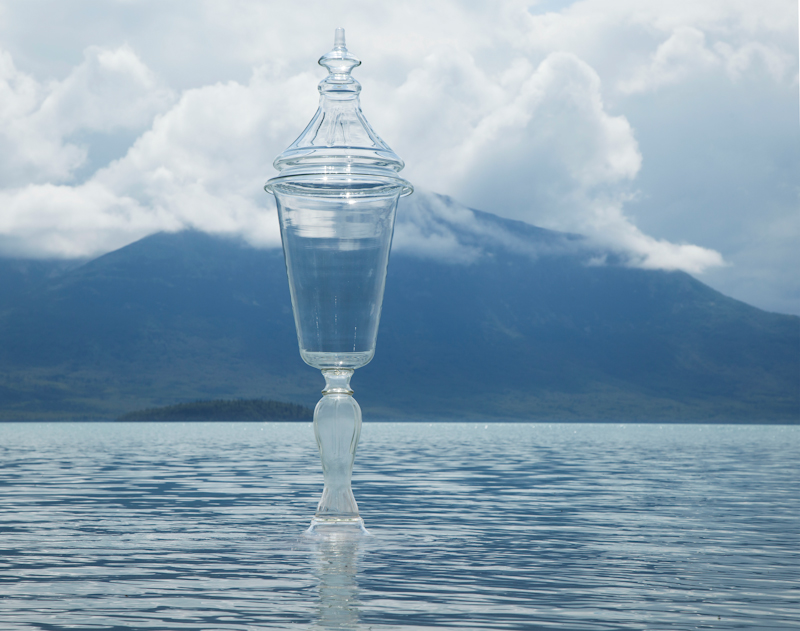BETH LIPMAN: Middle of the Story
Christian Petersen Art Museum
Iowa State University
Campbell Gallery, 1017 Morrill Hall
August 25, 2025 – February 13, 2026
ABOUT THE EXHIBITION
In concert with the arrival of the newest sculpture to the Art on Campus Collection, Hive Mind by artist Beth Lipman, University Museums presents a selection of Lipman’s exceptional multimedia sculptures and two-dimensional works of art. The works of art represent a lineage of Lipman’s dynamic explorations into the layering of time examining the intertwining of humanity and nature. From her series of laid tables—featuring an overflowing abundance of fruits, foods, and material culture, all rendered in glass—to her more nuanced photographic images that place glass objects and non-natural elements within various landscapes to address broader environmental concerns, the exhibition surveys Lipman’s research-driven process and her deep connection to the people and places her art engages with. Each installation and object in the exhibition Middle of the Story demonstrates how Lipman deftly uses material culture to represent time and place in three dimensions, culminating in the development and installation of Hive Mind, a major public work of art dedicated to the past, present, and future of the impactful research and people at Iowa State University.
This exhibition is curated and organized by Beth Lipman and University Museums.
Support is provided by the National Endowment for the Arts and the Iowa Arts Council, which exists within the Iowa Economic Development Authority. Generous support for the exhibition was also given by Stewart L. Burger, Wilson Family Endowed Exhibition Fund, Paul and Lynn Hempe, Liz and Randy Hertz, Art Bridges, Marilyn and Paul Gennett, and University Museums Membership.
ABOUT BETH LIPMAN
American, b. 1971, New York, NY
lives and works in Sheboygan Falls, WI
Beth Lipman is an American artist whose sculptural practice generates from the Still Life genre, symbolically representing the splendor and excess of the Anthropocene and the stratigraphic layer humanity will leave on earth. Assemblages of inanimate objects and domestic interiors, inspired by private spaces and public collections, propose portraits of individuals, institutions, and societies.
Temporality and mortality-primary concerns linked to the Still Life tradition are heightened through materiality. Works in glass, wood, metal, photography, and video disrupt the mechanisms of fixed, grand narratives in order to emphasize evanescence at the heart of ‘vanitas’. Sculptural processes become analogies for life cycles, pointing to systems both natural and human that must continually adapt in order to survive.
The works are a meditation on our relationship to Deep Time, a monumental time scale based on geologic events that minimizes human lives. Each installation is a reimagining of history, created by placing cycles often separated by millennia in proximity, from the ancient botanical to the cultural. The incorporation of prehistoric flora alludes to the impermanence of the present and the persistence of life. The ephemera of the Anthropocene become a symbol of fragility as the human species is placed on a continuum where time eradicates hierarchy.
Lipman has received numerous awards including a USA Berman Bloch Fellowship, Pollock Krasner Grant, Virginia Groot Foundation Grant, and a Louis Comfort Tiffany Foundation Grant. She recently completed One Portrait of One Man, a sculptural response to Marsden Hartley for the Weisman Art Museum (MN). Lipman has exhibited her work internationally at such institutions as the Ringling Museum of Art (FL), ICA/MECA (ME), RISD Museum (RI), Milwaukee Art Museum (WI), Gustavsbergs Konsthall (Sweden) and the Renwick Gallery of the Smithsonian American Art Museum (DC). Her work has been acquired by numerous museums including the North Carolina Museum of Art, Brooklyn Museum of Art (NY), Smithsonian American Art Museum (DC), and the Corning Museum of Glass (NY).





